America's next big climate action: Cutting methane pollution from the oil and gas industry
Quick takes:
- Methane pollution released today could warm the planet more over the next 10 years than carbon dioxide from burning fossil fuels.
- Methane frequently leaks or is purposely released at oil and gas sites nationwide, according to more than a decade of research led by the Environmental Defense Fund.
- The EPA has proposed measures to cut oil and gas methane pollution, including from smaller, low-producing wells that have escaped regulation in the past.
Melissa Ostroff was walking through Boyce Park, outside of Pittsburgh, Pennsylvania, when she was struck by the smell of sulfur and heard a loud, hissing noise. Bushwhacking her way off trail for a closer look, Ostroff, an advocate with the nonprofit Earthworks, quickly found the source — a broken gas well.
Using a special infrared video camera that can spot oil and gas leaks invisible to the naked eye, Ostroff saw a plume of climate-polluting methane spewing from the well, likely accompanied by smog-forming and cancer-causing chemicals associated with natural gas.
There are about 267,000 active oil and gas wells in Pennsylvania. The vast majority are older, less productive wells like this one, which are not covered by the Environmental Protection Agency’s existing regulations to limit methane pollution.
But in 2022, research from a team of Environmental Defense Fund scientists revealed that nationwide, hundreds of thousands of low-producing wells like these pose a big problem for the climate. They are responsible for half the methane pollution from all oil and gas wells.
Now, a new EPA proposal could at last require companies to frequently check for and address pollution from low-producing oil and gas wells. The agency could also limit flaring, the practice of burning off natural gas instead of collecting it — another source of methane and air pollution, and a major waste of resources when gas supplies are tight around the world.
Fight for cleaner air and a safer climate. Tell the EPA to cut methane.
Methane's climate-heating power
Methane pollution released today could warm the planet more over the next 10 years than carbon dioxide from burning fossil fuels, say EDF scientists. Research led by EDF has demonstrated that methane — the main component of natural gas — frequently leaks from oil and gas sites across the country.

When state and EPA regulators first began developing rules to limit oil and gas methane pollution, they focused on a small number of high-producing, newer wells. Smaller, so-called “marginal” wells that produce less than 15 barrels a day were often set aside, despite the fact that they number more than half a million — about 80% of active wells in the country.
“This has long been an area of debate and tension,” says Jon Goldstein, who directs EDF’s state and federal methane regulation work. “Regulators would give these wells a pass, based on the assumption that their small owners couldn’t afford to make changes, and that small wells didn’t pollute much anyway. But there was no real science behind that.”
In 2022, Mark Omara and a team of EDF scientists published research demonstrating just how big the small well problem actually is. Using measurements collected by 50 scientists in six different regions of the country, Omara estimated that small wells emit roughly half the methane pollution from all wells, and have the same impact on the climate every year as 88 coal-fired power plants.
What’s more, EDF showed that more than three-quarters of these wells are owned by companies that generate hundreds of millions in revenue each year — not exactly mom-and-pop shops.
“If you want a strong policy to reduce oil and gas methane pollution,” says Omara, “then that policy cannot leave out low-producing wells.”
Most methane leaks are easy to fix
Once notified, companies of any size can promptly fix most leaks, as they did with the leak Ostroff discovered in Boyce Park.
But, points out Vanessa Lynch, who lives near the park and is a field organizer for EDF affiliate Moms Clean Air Force in Pennsylvania, “It shouldn’t be up to you and me to find leaks. Companies should be responsible.”
Lynch, EDF and other advocates have been urging the EPA to strengthen oversight of low-producing wells that dominate the U.S. oil and gas landscape, particularly in Appalachia. Efforts to improve leak detection have stalled in Pennsylvania, where 1.4 million people live within half a mile of an active oil and gas well.
“We really need a federal standard that sets a baseline for states to protect frontline citizens,” says Lynch.
The EPA is holding virtual public hearings on January 10, 11 and 12, and is accepting public comment on its proposal until February 13, 2023. The final rule is expected in 2023.
A version of this article will appear in the Winter 2023 edition of EDF’s Solutions magazine. Join EDF and receive the magazine for free!










